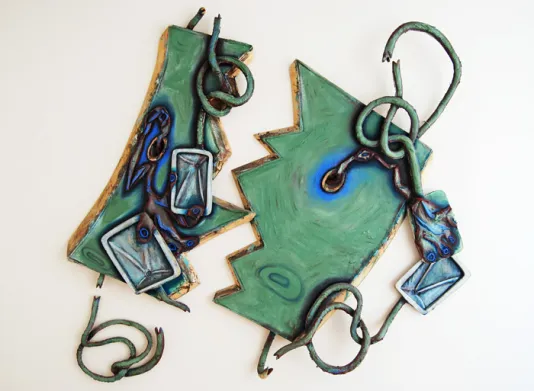Elizabeth Murray, Cast-a-way, 1992. Gift of Kitty and Herb Glantz. © 2025 The Murray-Holman Family Trust / Artists Rights Society (ARS), New York
Cast-a-way, 1992

Best known for her fragmented and shaped canvases, Elizabeth Murray makes paintings that are neither fully abstract nor representational.
They are also not truly paintings, as their eccentric compositions and varied materials are often suggestive of sculpture. Cast-a-way is a prime example. Its two canvases have jagged, zigzagging edges that imply that they were once a singular form; a series of painted wooden rope-like elements attached to or perforating the canvases are both knotted and severed, rigid and curving. While these elements remain formal and abstract, the work’s title suggests a larger narrative: perhaps this piece was salvaged from a sinking ship as its components were beginning to drift apart.
Murray’s work is often populated with forms that allude to everyday objects or parts of bodies, and with imagery that is charged with sexuality, humor, and violence. Her vibrant palettes enhance compositional and thematic divides. In Cast-a-way, an electric blue hue highlights mysterious cavities that are sites of the emergence or penetration of forms, while the more representational elements—chained and shriveled hands or feet springing from those symbolic openings—are rendered in sickly browns, both cartoonish and grotesque. Molded from crumpled canvas, those human appendages seem to grasp at the lighter blue rectangular shapes as if attempting to piece the work back together, or to escape the piece altogether.
Elizabeth Murray (1940–2007) was born in Chicago and earned a BFA at the School of the Art Institute of Chicago and an MFA from Mills College in Oakland, California, in 1964. After teaching in Amherst, New York, for two years, she moved to New York City. Inspired by the work of Paul Cézanne and Claes Oldenburg, her work progressed through painting and sculpture, abstraction and representation, to a reconsideration of the still life as well as a focus on the shape and construction of paintings. Murray taught at California Institute of the Arts, Princeton University, Yale University, and the School of Visual Arts. Among her awards are the Skowhegan Medal in Painting and a MacArthur Foundation Award. In 2005, she had a career retrospective at the Museum of Modern Art, New York, and her work is featured in many collections, including the Walker Art Center, Minneapolis; Nelson-Atkins Museum of Art, Buffalo; the Museum of Modern Art, New York; the Solomon R. Guggenheim Museum, New York; the National Gallery of Art, Washington, D.C.; the Art Institute of Chicago; and the Museum of Contemporary Art, Los Angeles, among others.
